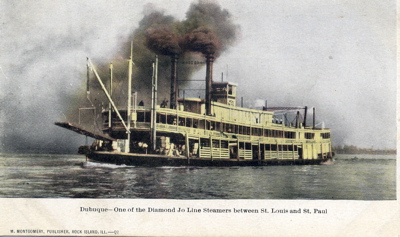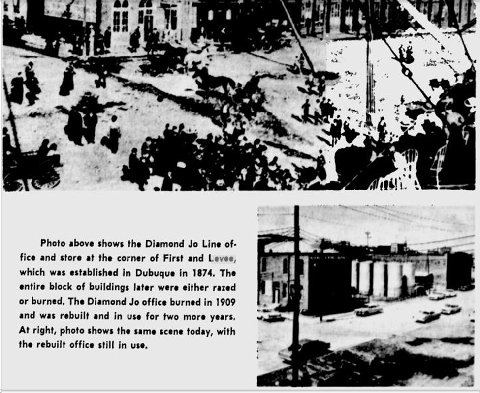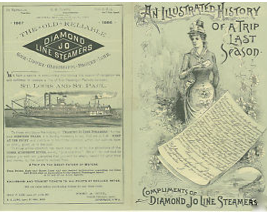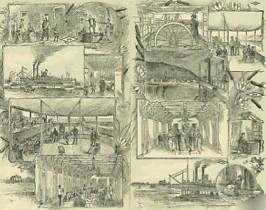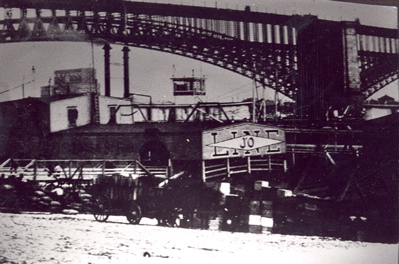Encyclopedia Dubuque
"Encyclopedia Dubuque is the online authority for all things Dubuque, written by the people who know the city best.”
Marshall Cohen—researcher and producer, CNN
Affiliated with the Local History Network of the State Historical Society of Iowa, and the Iowa Museum Association.
DIAMOND JO LINE
This entry is being edited.
DIAMOND JO LINE. In December 1977, the former Diamond Jo Boat Store and Office, now property of Inland Molasses Company at Jones and Terminal STREETS, was added to the NATIONAL REGISTER OF HISTORIC PLACES. The building, which once had an office at the end facing the river and a steamboat warehouse behind it, is the only remaining building in Dubuque traceable to one of America's great steamboat companies.
The company was named for Joseph "Diamond Jo" REYNOLDS, a prosperous businessman who made fortunes in milling, tanning, RAILROADS, MINING, and shipping. The origin of his name, often the source of wild stories, came from his habit of surrounding his name Jo, for Joseph, with four lines suggesting a diamond. Another name remembered for his connection to the company was Captain John F. KILLEEN.
Reynolds felt that he had been treated badly by other business interests along the Mississippi. In 1860 he began his business buying grain, hides, and furs. His business expanded so quickly that he thought it necessary to have his own boats. In 1862 he purchased the steamer, "Lansing."
Before he had operated it for long, the Minnesota Packet Company operating between Dubuque and St. Paul convinced Reynolds to sell them the boat while promising him that his business would be treated fairly. Before the end of the season, he found these promises to be worthless.
Reynolds retaliated during the winter of 1862-1863 by constructing the steamer "Diamond Jo" and the barges "Fleming" and "Conger." He had other boats constructed and purchased others like the "Pittsburg" and "Gem City" from the Davidson line when it went out of business. The "Pittsburg" was renamed the "Dubuque."
In 1874 a building in Dubuque was constructed as the main office of the Diamond Jo Steamers. Originally the company was primarily involved in transporting grain. As this declined, transporting passengers took on greater importance.
In 1878 the Diamond Jo Company spent about one hundred and fifty thousand dollars and located permanently at Eagle Point. J. A. Johnston had charge of the yards at first; seventy-eight men were employed in January, 1880. (1) The demand for quick river transit encouraged the Diamond Jo Company to construct fast steel-hulled passenger boats for travel from St. Louis to St. Paul.
By July, 1885, the ice harbor was practically completed. The J. K. Graves, an iron hull rafter, was built in the ice harbor in 1885. The Van Sant & Musser Transportation Company ordered a large rafter in Dubuque early in 1886; it was called Glenmont and was 137 feet long. (2)
Working together the Diamond Jo Company built the upper portion and the IOWA IRON WORKS constructed the iron and steel sections. With Joseph Reynolds as president and general manager and Ernest M. DICKEY the superintendent the Diamond Jo Line built a barge with a double steel hull in 1886.
With the death of Reynolds in 1891, the company belonged to and was operated by his brother-in-law, Jay Morton of Chicago.
On February 3, 1911 the company was sold to the Streckfus Company of Rock Island. For $200,000 the Streckfus Company obtained the steamers St. Paul, Quincy, Dubuque and Sidney. In addition it received the wharves, warehouses and boatyards of the company.
The Streckfus Company announced that it intended to remodel the Sidney into a first class excursion boat to take the place of the J. S. which was destroyed by fire near Trempealeau, Wisconsin during the summer of 1910. The Sidney was to be ready for the excursion season beginning on May 1st and would sail between Peoria and St. Paul during the summer and south at New Orleans during the winter. The other three steamers would be refitted and placed into regular packet trade between St. Louis and St. Paul during the summer and St. Louis to New Orleans during the winter. While general offices of the new company would remain in St. Louis, it was announced that Dubuque would remain important since it was a midway point between there at St. Paul.
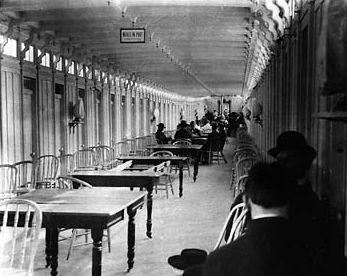

Diamond Joe Line
1867, called Chicago, Fulton and River Line, Headqtrs. Fulton, Ill.
1874, Headquarters moved to Dubuque,
Owner: Joseph Reynolds
Officers: 1880, shortly after superintendent, Capt. John Killeen
Boats Constructed:
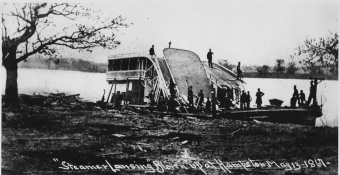
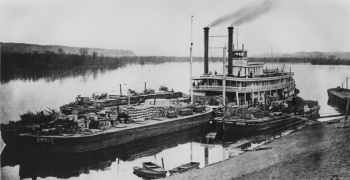
1867, JOHN C. GAULT, propeller driven towboat.
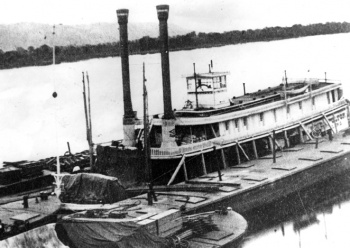
186?9?, early spring?,-72, LADY PIKE
1869, July, Chartered STERLING to help with enormous work load.
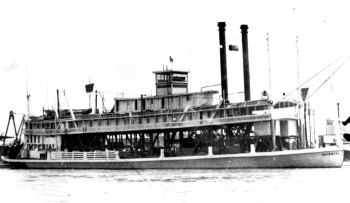
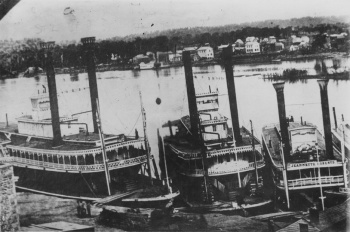
1871, Chartered briefly, BANNOCK CITY
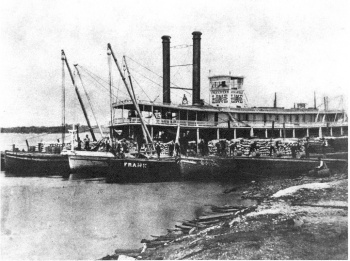

1873-81, IMPERIAL a powerful towboat
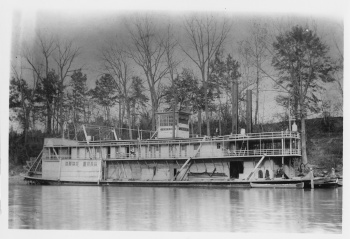
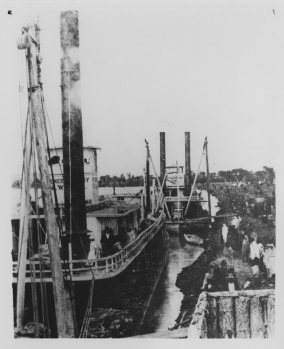

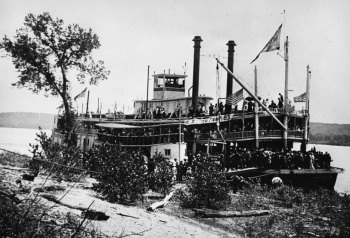
189?-1901 WASHINGTON
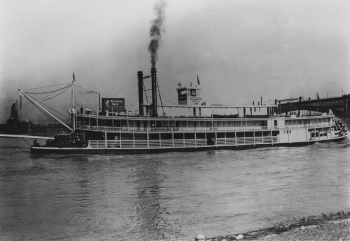
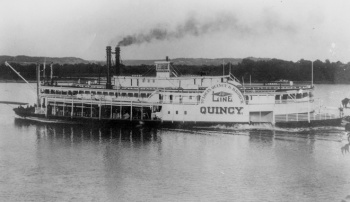
---
Source:
1. Oldt, Franklin. History of Dubuque County, Iowa. Chicago: Western Historical Company, 1880. Online: http://www.ebooksread.com/authors-eng/franklin-t-oldt/history-of-dubuque-county-iowa-being-a-general-survey-of-dubuque-county-histor-tdl/page-26-history-of-dubuque-county-iowa-being-a-general-survey-of-dubuque-county-histor-tdl.shtml
2. "Dubuque, A Boat Building Center," Telegraph Herald, August 21, 1910 Part II, p. 1
"Diamond Jo Line Boats are Sold," Telegraph Herald, February 3, 1911
Hudson, David; Bergman, Marvin; Horton, Loren. The Biographical Dictionary of Iowa. Iowa City: University of Iowa Press, 2008
Riverboat Dave's. "Riverboat Companies and Owners," Online: http://www.riverboatdaves.com/owners/d.html



